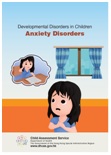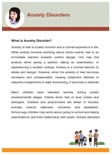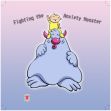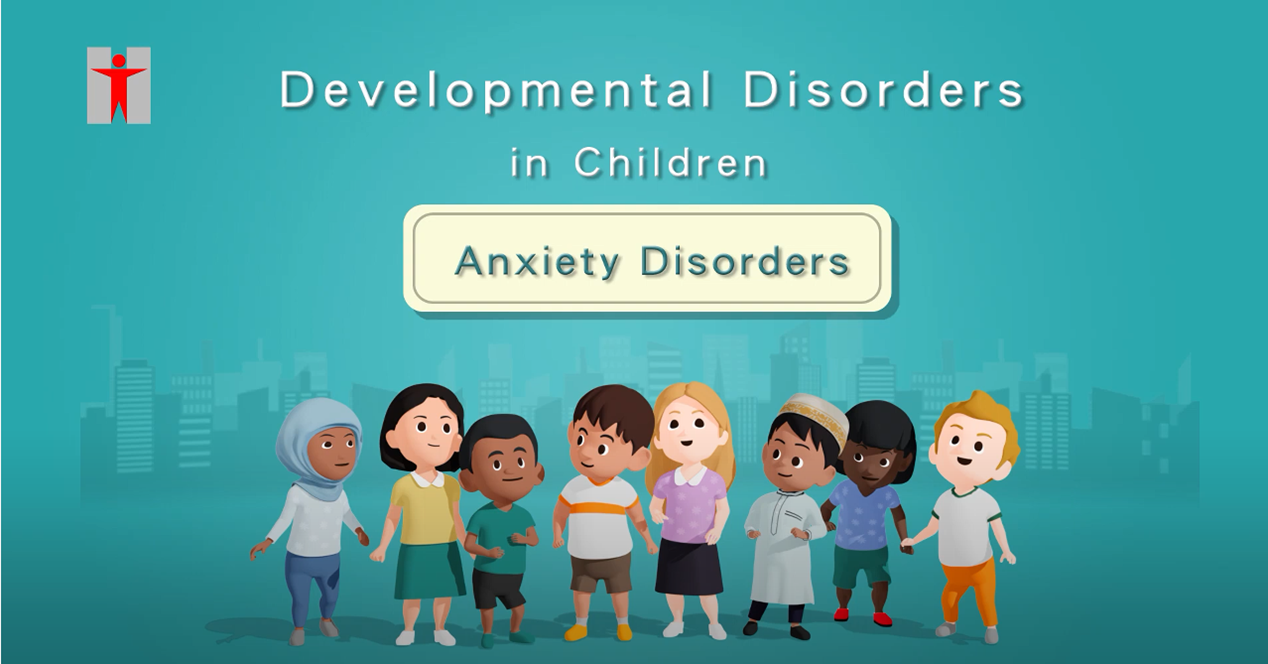Anxiety Disorder
Anxiety or fear is a basic emotion and a normal experience in life. While anxiety involves worrying about future events, fear is an immediate reaction towards current danger. One may feel anxious when giving a speech, taking an examination, or experiencing a sudden change. Anxiety is a normal reaction to stress and danger. However, when the anxiety or fear becomes excessive and unreasonable, causing subjective distress or objective impairments in daily functioning, it becomes a disorder.
Many children have transient worries during certain developmental stages. Infants show fear of loud noises and strangers. Toddlers and preschoolers are afraid of thunder, animals, insects, darkness, monsters, and separation. School-age children may worry about going to school and taking examinations, and their relationship with peers. Anxiety disorders are different from the developmentally normal fear or anxiety in that they are excessive, persistent, or extending beyond the developmentally appropriate periods. While normal anxiety alerts an individual to cope with the danger, pathological anxiety often occurs in the absence of an actual threat.
Anxiety disorders commonly seen in children:
Social Anxiety Disorder (Social Phobia):
- Show intense fear when facing unfamiliar people, and appear uneasy in social gatherings or become nervous when being expected to start conversations with others.
- Show marked fear when they become the centre of attention, or when there is possible evaluation from others, such as performing on stage or being called on in class.
Separation Anxiety Disorder:
- Show developmentally inappropriate and excessive anxiety when being separated from parents or caregivers.
- Often worry about losing their parents or about any possible harm that might come to them, resulting in reluctance of being alone, calling parents who are away for assurance, or even school refusal.
Selective Mutism:
- Consistently fail to speak at specific social situations (such as in school or social gatherings), despite speaking normally in other situations in which they feel safe and comfortable (usually at home).
Generalized Anxiety Disorder:
- Show excessive and uncontrollable worry about a number of everyday matters, e.g., academic results, peer relationship, family issues, even the idea of potential accidents or disasters.
- May present with irritability, concentration difficulty, or somatic complaints, such as sleeping problems, muscle tension etc.
Specific Phobia:
- Have an extreme and irrational fear of a specific object or situation, such as an animal, insect, injection, the sight of blood, height or darkness, etc.
- The feared objects or situations are usually avoided or endured with intense distress.
Anxiety disorders often cause significant interference in multiple domains of life. It affects children’s social relationships, daily routines, or academic functioning. Children suffering from anxiety disorders often have negative thinking styles and maladaptive behavioural patterns. They often overestimate the danger of objects or situations, and often react by avoidance coping. Some children may also present with temper problems. Physiological illnesses and psychosomatic complaints, such as headache, stomachache, sweating, and muscle pain are also frequently reported.
The irrational fears and avoidance behaviours often hinder children’s participation in social activities and friendship development, as well as affect their performance and involvement in school work, everyday contact with people, and daily functioning. Untreated anxiety disorders may persist into adulthood and lead to depression and substance abuse.
Adults with anxiety disorders may recognize that their fears or anxiety are excessive or unreasonable. However, such awareness may be absent in children. It may be difficult for children to explain their fears and worries verbally, particularly for younger ones. It is therefore important for parents to pay attention to signs and symptoms of anxiety. Changes in behaviour or increased tantrums are common red flags of stress and anxiety in children. Some children may also develop nervous habits, such as nail-biting, hair-pulling, or chewing on pencils. Other common signs include changes in sleep pattern or appetite, as well as somatic complaints.
Anxiety disorders are the most common form of psychiatric disorders in children, with a prevalence rate of approximately 7% overseas. In general, more girls are affected than boys. The local prevalence estimates and gender differences are largely compatible with those reported in Western countries.
The exact causes and mechanisms of anxiety disorders are not fully known. However, research suggests that biological, psychological, and environmental factors interact with each other in the development of anxiety disorders.
Biological factor:
Anxiety disorders often run in families and genetic factors are believed to predispose some individuals to anxiety disorders. Imaging studies also indicate that people with anxiety disorders have atypical activities in specific areas of the brain, including the prefrontal cortex, limbic system, amygdala and thalamus.
Besides, abnormal levels of neurotransmitters (chemicals in the brain for transmitting information between nerve cells) also play a part in the cause of anxiety.
Psychological factor:
Psychological causes of fears and worries in children with anxiety disorders may include negative thinking, reluctance to making attempt, perfectionistic thinking, and fear of making mistakes. These thinking styles often result in apprehensive expectations when facing stress and difficulties.
Environmental factor:
External sources of anxiety and stress in children may include academic difficulties, conflicts with friends, family problems, etc. Parents’ attitudes and reactions may also affect the development and maintenance of anxiety problems in children. Parenting style, such as over-protectiveness, may exacerbate the problem. Sometimes parents may reinforce children’s anxious or avoidance behaviour unintentionally, such as giving excessive soothing. Children may also “learn” the anxious behaviour from parents through observation and modeling.
Comorbidities of multiple anxiety disorders or with other emotional and behavioural problems are commonly found among children with anxiety disorders. Compared to the normally developing peers, children with anxiety disorders are more likely to have comorbid depressive mood and attention and hyperactivity / impulsivity problems.
Choices of treatment depends on the type and severity of the anxiety problem. While psychological intervention is commonly used in the treatment of childhood anxiety, children who are older and with more severe symptoms may receive pharmacological treatment when psychotherapy cannot address symptoms adequately.
-
Psychological treatment:
Individual or group cognitive behavioural therapy (CBT) is recommended as the first-line treatment. It addresses the interplay of thought, behaviour, and physiological responses that contributes to anxiety. Parents or carers are often involved to ensure the effective delivery of the treatment, especially in young children.
- Thought — Children are guided to identify, challenge, and change their irrational beliefs (e.g. "If I am not perfect, I am a failure"). As such approach demands certain level of cognitive ability and maturity, preschool or early primary school children are sometimes taught to use positive thoughts to replace their negative or irrational thoughts directly (e.g. “Even if I can’t answer the question, I won’t be punished by teacher.”).
- Behaviour — Exposure to the fearful objects or situations may allow children to experience the harmless or uneventful outcome of their fears. It is usually done in a graded manner, with the exposure exercise starting from a mildly anxiety-provoking situation, and gradually progressing to a more challenging and provoking situation.
- Physiological response — Relaxation techniques, such as regulated breathing, muscular relaxation, and mindfulness can help children reduce or manage the physiological symptoms of anxiety and increase feelings of emotional well-being.
Children younger than seven typically do not yet have the cognitive ability to understand and apply the strategies on their own. CBT adapted for parents of children with anxiety disorder, family-based CBT with heavy parental involvement, and adapted Parent-Child Interaction Therapy (PCIT) have been found to be helpful. Parents play an important role in the treatment process,
-
Medication:
Selective serotonin reuptake inhibitors (SSRI), selective noradrenaline reuptake inhibitors (SNRI) are commonly used to help relieve anxiety symptoms. On the other hand, benzodiazephine may be used to reduce the physiological symptoms (such as muscle tension). Some medications are fast-acting while others may take a few weeks to reach their full effects. The rationale for selecting a particular type of medication, the possible side effects, and the availability of other treatment options should be discussed with the parents. It is important to note that changes in dosage or type of medication, or discontinuation of medication should be done only under doctor’s supervision.
- Child Assessment Service of the Department of Health offers behavioural and developmental assessment for children, and interim support in the form of information workshops and treatment groups.
- Child and Adolescent Mental Health Services of Hospital Authority provide pharmaceutical and psychological treatments for children with anxiety disorders.
- Educational psychologists offer school-based support to teachers and children in need.
- Some non-governmental organizations provide child training and parent support activities.
Current research evidence is still inconclusive. Yet, if children with excessive amount of anxiety are left without treatment, the condition is likely to persist or exacerbate. In contrast, the prognosis is generally good if timely and appropriate treatment is given.
- Child and Adolescent Mental Health Community Support Project
http://www.ha.org.hk/CAMcom - United Centre of Emotional Health & Positive Living
http://www.ucep.org.hk - American Academy of Child & Adolescent Psychiatry
http://www.aacap.org - Anxiety Disorders Association of America
http://www.adaa.org - American Psychological Association
http://www.apa.org - Centre for Emotional Health
http://www.emotionalhealthclinic.com.au/ - National Institute of Mental Health
http://www.nimh.nih.gov
- American Psychiatric Association (2013). Diagnostic and statistical manual of mental disorders (5th ed.). Washington, DC: Author.
- Centers for Disease Control and Prevention. (2021, March 22). Data and statistics on children's mental health. Centers for Disease Control and Prevention. Retrieved September 27, 2021, from https://www.cdc.gov/childrensmentalhealth/data.html.
- Dougherty, L. R., Tolep, M. R., Bufferd, S. J., Olino, T.M., Dyson, M., Traditi, J., Rose, S., Carlson, G. A., & Klein, D. N. (2013). Preschool anxiety disorders: Comprehensive assessment of clinical, demographic, temperamental, familial, and life stress correlates. Journal of Clinical Child & Adolescent Psychology, 42(5), 577-589.
- Gullone, E. (2000). The development of fear: A century of research. Clinical Psychology Review, 20(4), 429-451.
- Huberty, T. J. (2012). Anxiety and depression in children and adolescent: Assessment, intervention, and prevention. New York: Springer-Verlag.
- Heather J. Walter, H.J., Bukstein, O.G., Abright, A.R., Keable, H., Ramtekkar, U., Ripperger-Suhler, J., & Rockhill, C. (2017). Clinical Practice Guideline for the Assessment and Treatment of Children and Adolescents with Anxiety Disorders. Journal of American Academy of Children and Adolescent Psychiatry, 59(10), 1107-1124.

Short Factsheet

Long Factsheet

Fighting the Anxiety Monster
